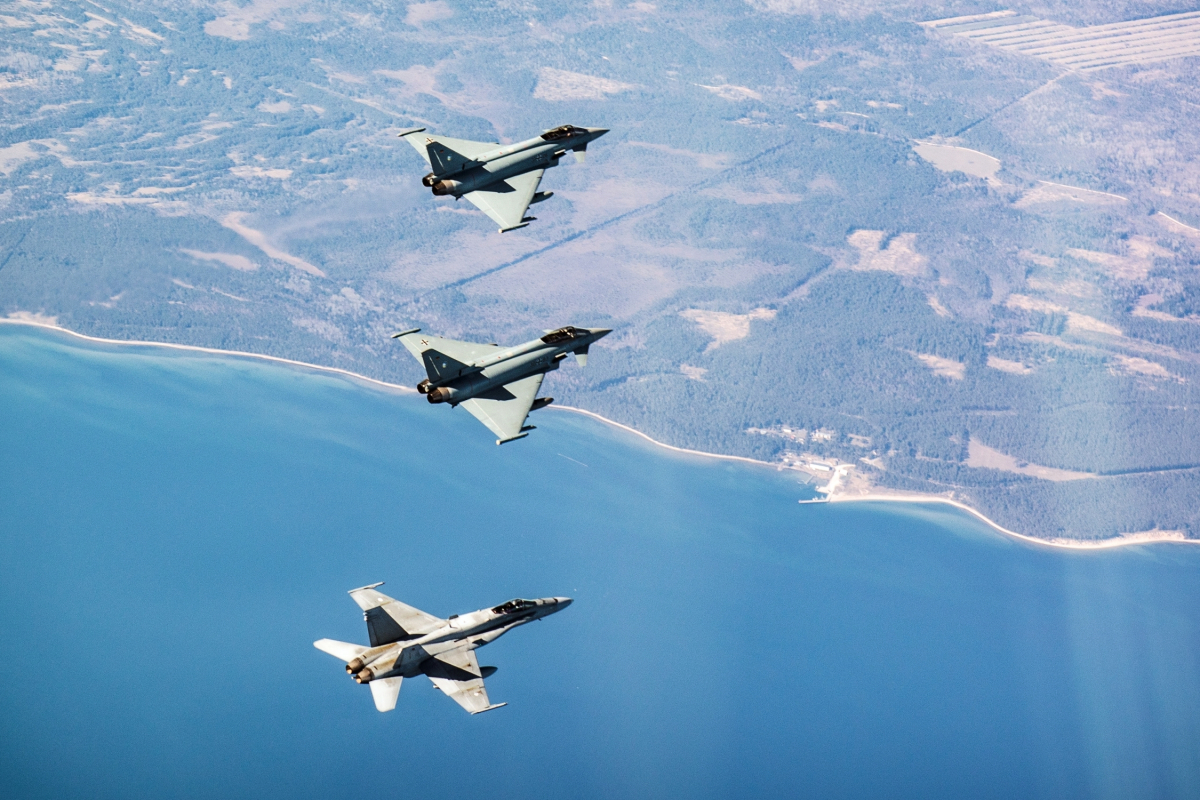For two days, two dozen aircraft and ground forces jointly trained for air defense operations in the Baltic. This exercise is part of NATO's recently adopted defense and deterrence policy. It is also taking place not far from the Kaliningrad exclave, whose Russian military potential is constantly monitored by numerous reconnaissance and electronic warfare aircraft.
Ramstein Alloy
On September 26-27, Hungary, Germany, Spain, the Czech Republic, Italy, Turkey, the United Kingdom, Estonia, Lithuania and Latvia, and Finland conducted another Ramstein Alloy exercise (the third this year). The aim of the exercise is to exercise the interoperability of the air forces of NATO member states as well as partner states, in this case Finland. This exercise is each time focused on the Baltic Sea region.
During the two days, multiple operations were conducted:
- alert takeoff of fighter aircraft to intercept an aircraft that has lost its communication systems or a slow aircraft
- close air combat simulations or Close Air Support (CAS)
- Combat Search and Rescue (CSAR)
A special highlight during this edition is the training of Spanish operators of the NASAMS system deployed as part of NATO to defend the Lielvārde air base (Latvia). The exercise planner, squadron leader Craig Docker, rightly stated:
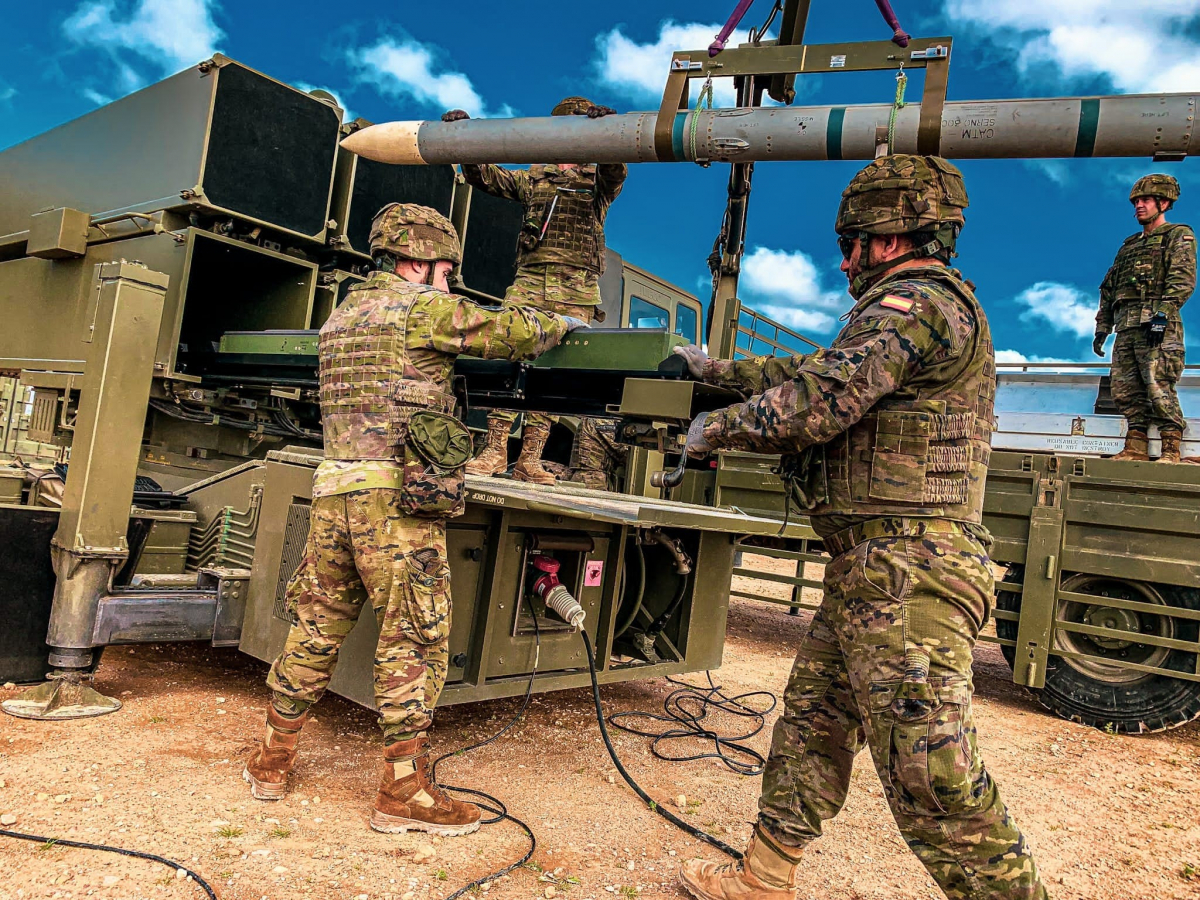

"For the first time, we are including both air and ground air and missile defense activities in our exercises. This highlights how the Allies are protecting the eastern flank and - at the same time - preparing for a meaningful execution of NATO's deterrence and defense concept in the Baltic region. We are also training Air-Ground Integration tactics, techniques and procedures with Czech jets and Enhanced Forward Presence Battlegroup [eFPB] or Air Support Controllers[JTAC] improving the ability of our pilots and soldiers to work together in a multinational environment."
A total of two dozen aircraft were deployed for the training, including two advanced air-watch and control (AEW&C/AWACS) aircraft;
- A NATO E-3A Sentry (Luxembourg-registered). Recognizable by its rotating radome, this modified and upgraded Boeing 707 belongs to the NATO AWACS fleet (14 in total). It is mainly used to detect airplanes or helicopters within an airspace thanks to the 400 kilometer range of its rotating radar. It also serves as a command post for air operations.
- Another AWACS was also deployed. It was a Turkish E-7A Wedgetail. Unlike the Sentry, it has a sideways and stationary radar. However, this Multi-Role Electronically Scanned Array (MESA) radar is much more effective than the mechanical radar of an E-3 Sentry: the operator can decide to track a target of interest much more often than an operator of a mechanical radar, which depends on the number of rotations per minute of its radar, whereas the MESA depends only on the electrical pulse sent to the sensors. The MESA is also a radar that can increase its detection range in certain areas by increasing the electrical power in the radar. By the way, the Wedgetail seems well on its way to replacing the E-3 Sentry in NATO as well as in the USAF (article on the subject).
Defense and Deterrence
Ramstein Alloy 2022-3 is part of a dual focus; defensive, as already demonstrated above, but also deterrent. Deterrence does not only involve nuclear weapons. The United Kingdom paid the price in the early 1980s. The Thatcher government decided to increase the budget for nuclear deterrence to the detriment of the other items in the Armed Forces, with a view to the Cold War. It was at this point that Argentina decided to invade the Falklands. Deterrence thus remains primarily conventional, while including deterrence with nuclear delivery systems. In fact, the demonstration of NATO member countries' Air Force aircraft projection capabilities in the Baltic demonstrates this classical deterrence capability: in the event of an invasion or attack, the assets present there but also within the member countries can respond quickly and effectively to a possible threat.
.
Constant surveillance
In order to avoid any surprises, staffs need a constant flow of intelligence on the various dangerous areas. This is especially the case in Kaliningrad as numerous aircraft were patrolling around or adjacent to the borders of the Russian exclave, including visible (in addition to the two radar lookout aircraft deployed for the Ramstein Alloy 2022-3 exercise) in the image below.
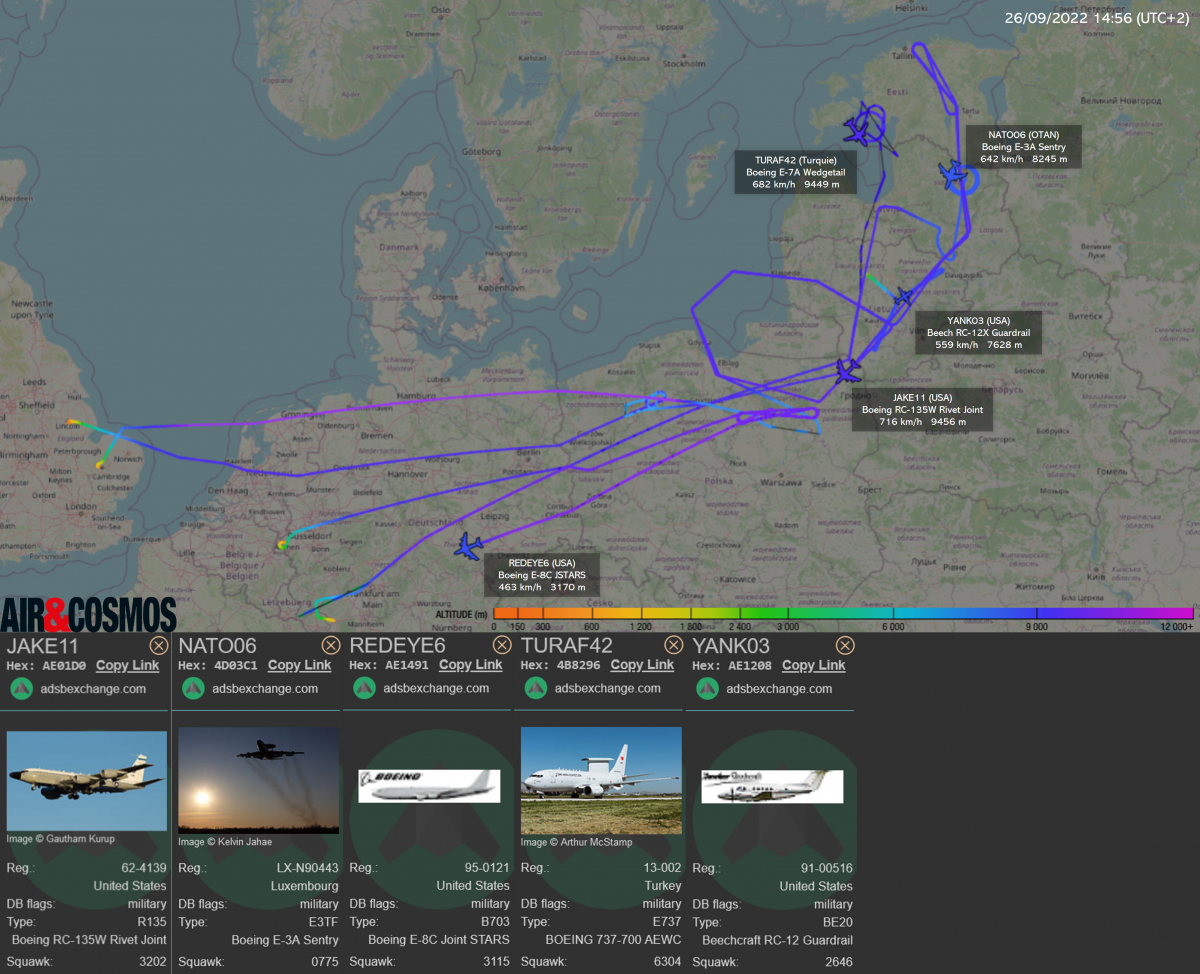

Two of the deployed aircraft specialize in the collection, identification and geolocation of communications (COMINT) and miscellaneous electronic signals such as radar emissions, jammers, etc (ELINT). These are the USAF's RC-135W Rivet Joint and the smaller RC-12X Guardrail of the US Army. Both aircraft are familiar with Eastern Europe, as the American and British RC-135V/W Rivet Joint patrols near the Russian and Belarusian borders and over the Black Sea. The RC-12X is part of an American contingent deployed in Lithuania with a total of three RC-12X. Instead, these aircraft are deployed around Kaliningrad and belong to the U.S. Army.
The fifth visible aircraft is an E-8C JSTARS airborne ground surveillance (AGS), combat management and command and control (C2) aircraft. This aircraft is specially equipped to track vehicles on the ground and especially armored vehicles, thanks to its AN/APY-3 radar. The latter is located under the fuselage of the aircraft and has a range of 250 kilometers. Normally, the USAF would retire its last JSTARS in 2025 (article on the subject).
EAA and Sweden on Kaliningrad
A few days earlier, on September 23, Kaliningrad was also under surveillance, as shown in the image below.
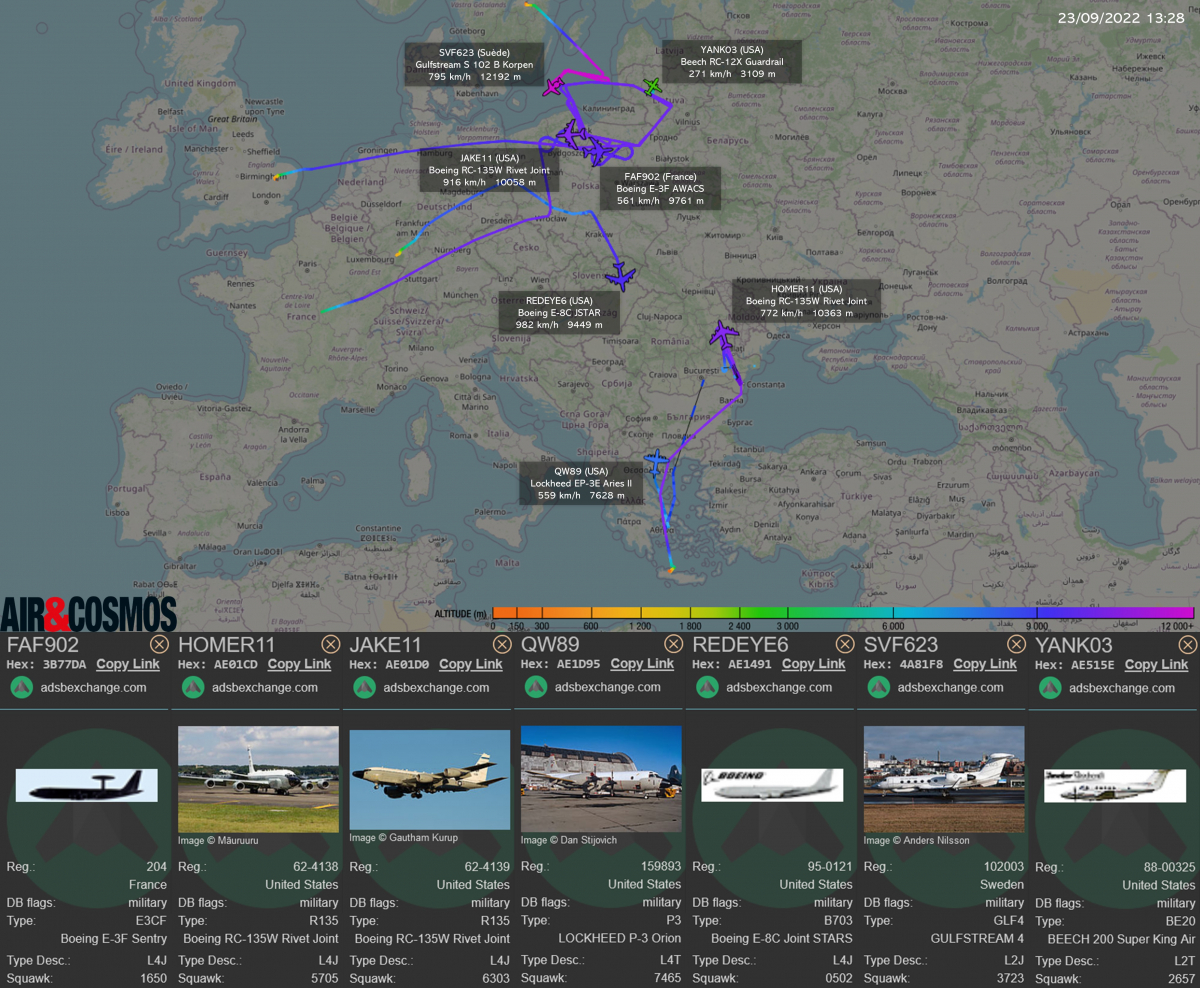

In addition to a U.S. RC-135W and RC-12X, these aircraft were accompanied by:
- An Air Force E-3 Sentry AWACS. The AAE has four of these, in the E-3F standard. They are deployed from the 702 air base in Avord (Cher) within the Airborne Detection and Control Squadron (EDCA) 00.036 "Berry". In service since 1992, these four aircraft received a mid-life upgrade between 2014 and 2016. They are upgraded to Block 40/45 standards, equivalent to the USAF's E-3G Sentry. This is a real revival for these aircraft; complete renovation of the consoles, glass cockpit, improved IFF, renovated and modernized electronic systems, etc. In fact, the DGA recently announced that they should be using the new generation Link 16 before the end of the year (more info in this article).
- a Swedish Air Force S 102 B electronic intelligence aircraft. Only two aircraft are in service and use only censors allowing the analysis of ELINT data (radars, weapons systems,...). Nevertheless, the various modifications make the aircraft in question three tons heavier than the civilian version, the Gulfstream G-IV. Sweden was threatened by Russia the day after the invasion of Ukraine (see the beginning of this article). Sweden is also interested in the various Russian troop movements in the Baltic since as early as February 25 (i.e., 24 hours after the Russian invasion of Ukraine), the spokeswoman for the Russian Foreign Ministry announced that Sweden and Finland would not be able to join NATO:
"[...]Finlandand Sweden should not base their security on damaging the security of other countries and their accession to NATO may have detrimental consequences and face multiple political consequences. [...]"
The Southeast Border
A JSTARS is also visible over Central Europe. It was heading for the southeastern border of NATO. This is where a second RC-135W was on patrol but also a much rarer EP-3E Aries II. This is a modified version of the P-3 Orion maritime patrol aircraft. What's more, today, only 16 of these aircraft are in service and the US Navy is expected to retire them soon and replace them with drones by 2025. It is the only electronic intelligence aircraft in service with the US Navy. It is capable of detecting, identifying and geolocating any electronic emissions (COMINT or SIGINT).
These aircraft also sometimes patrol over the Black Sea. Their objective is to gather intelligence on Russian troops in Crimea, while patrols in northeastern Romanian airspace are more focused on Russian troops located in the Kherson area.
>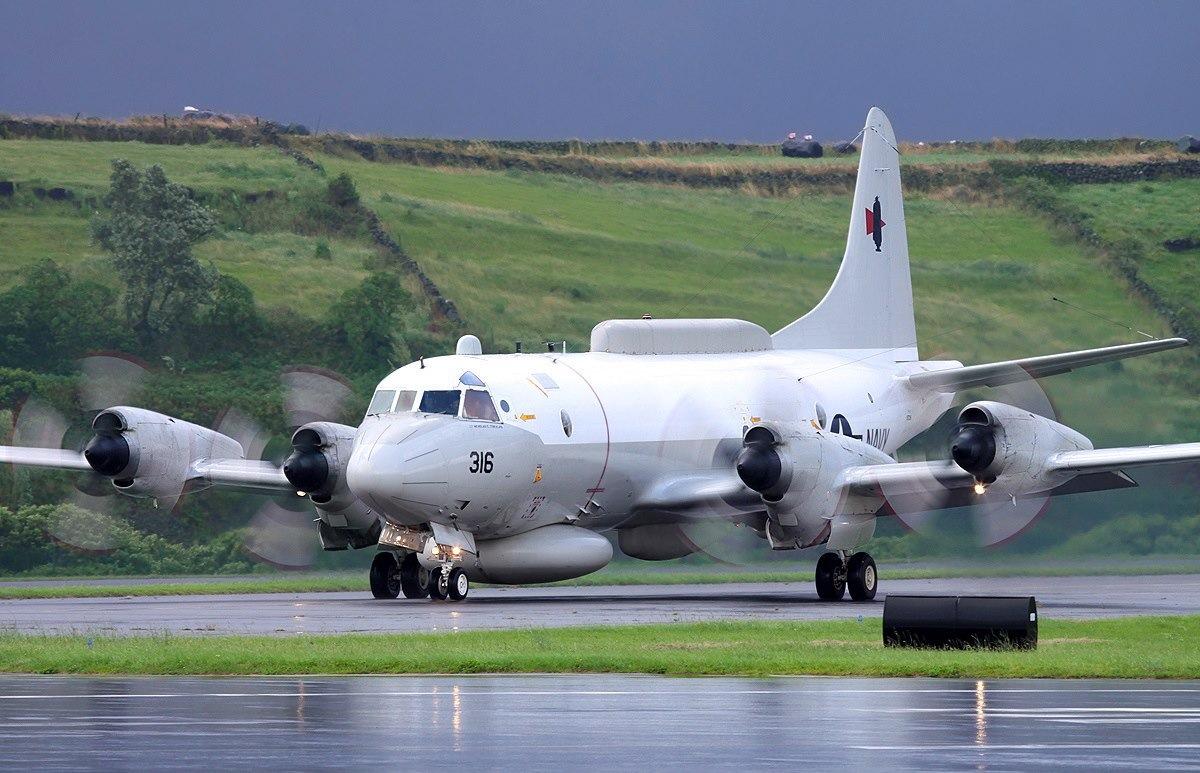

Découvrez cet article sur Air&Cosmos

